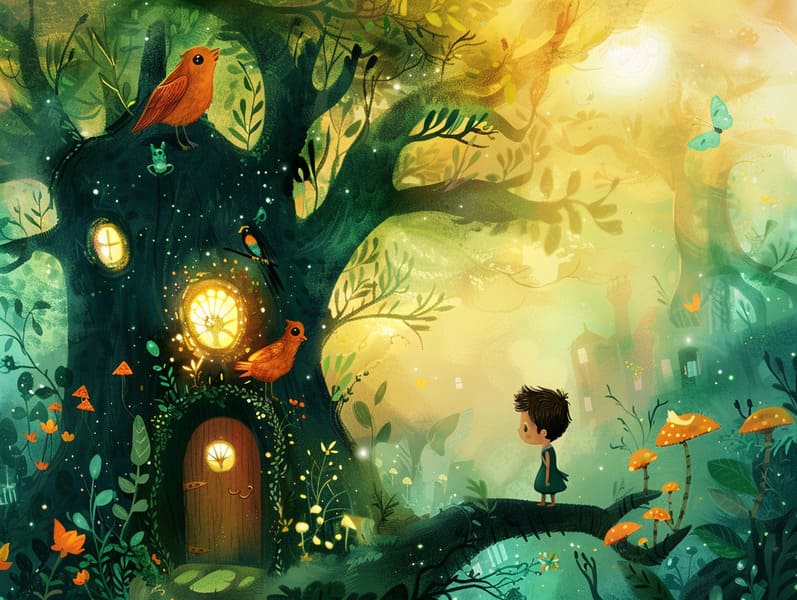
Children's fairy tales have long histories. These tales have been passed down from one generation to the next millennia before they were ever recorded. They sprang from a variety of societies, including Indigenous traditions. They were initially shared among older generations, often carrying themes and messages pertaining to the societal norms and beliefs of the time.
The renowned Brothers Grimm, Jacob and Wilhelm, were among the first to collect many of these beloved narratives. Their published works, "Grimm's Fairy Stories," included tales like "The Story of Cinderella," "The Bread Crumb Trail," and "Schneewittchen," which have since become essentials in the world of children's fairy tales. Similarly, the Danish author's fantastical fairy tales, such as "The Little Mermaid," and "The Little Duckling," have touched hearts worldwide, securing their place in the pantheon of timeless fairy tales.
Even though they are old, these tales remain as applicable as ever, especially as children's night stories. These whimsical stories are now available in diverse formats, including colorful picture books, charming animations, and online fairy tales.
Their unwavering allure can be credited to several whimsical characteristics:
Significant Morals: Timeless fairy tales often illustrate important moral lessons. Fairy tales like "The Boy Who Cried Wolf" teach the value of truthfulness, while "The Race of the Tortoise and the Hare" point out the qualities of resolve and humbleness. These narratives offer young ones clear distinctions between virtue and vice, developing their moral compass in a gentle yet impactful way.
Warmth and Understanding: Old fairy tales frequently portray heroes facing tests and troubles, inciting young readers to comprehend with their struggles and support their triumphs. For instance, "Beauty's Beast" emphasizes the necessity of appreciating inner worth to know the inner being of a person, encouraging empathy and understanding.
Cultural Insights: Many fairy tales are deeply embedded in the cultural contexts from which they emerged. Reading these fairy tales can provide illuminating insights into different traditions, building a sense of world insight and comprehension.
Fantasy and Imagination: The supernatural elements in timeless fairy tales—enchanted objects—activate children’s imaginations. These fairy tales move readers to imaginary realms, fostering fantastical thinking and a sense of awe that lasts a lifetime.
Classic fairy tales are not only bewitching but also didactic. They provide fantastical tools in promoting various brain and heart skills in kids. When timeless fairy tales are read aloud, they foster speaking abilities by bringing new language and sophisticated sentence structures. This practice also fosters hearing perception and concentration, as young readers hang on every word, eager to see what happens next.
Furthermore, contemplating the themes and characters of old fairy tales can strengthen logical thinking and logical thinking. Children are instructed to identify patterns, predict happenings, and comprehend cause and effect. These reflections also encourage children speak out their thoughts and feelings, promoting their emotional intelligence.
In today’s technological age, the availability of online storybooks has made these tales more available than ever. Online resources and online apps provide vast collections of timeless fairy tales that can be accessed or heard anytime, anywhere. Fairy tales spoken are particularly common, extending an captivating way for kids to take part in these fascinating tales. Audio stories and read-out-loud stories carry characters and settings to life, often supported by enchanting audio effects and instrumentals that boost the storytelling experience.
The enduring charm of timeless fairy tales lies in their ability to shift to modern days while holding onto their underlying messages. Contemporary renditions of these fairy tales often present more diverse figures and modern settings, making them pertinent to today’s audience. However, the essential messages of bravery, kindness, and fair-mindedness remain unchanged, continuing to impact audiences of all ages.
Old fairy tales also offer a sense of serenity and knownness. They allow a well-structured narrative with a clear beginning, middle, and end, often drawing to a close with the culmination of conflicts and the triumph of virtue over vice. This foreseeability can be encouraging for the young, yielding a sense of unwaveringness in an shifting world.
Traditional fairy tales continue to delight and educate new generations, maintaining their grace and importance in modern society. As kids' bedtime tales, they bring a perfect blend of delight and instruction, developing moral values, empathy, and creativity. The proliferation of free fairy tales online and the well-received status of click here fairy tales recited guarantee that these traditional tales remain accessible to new generations.
By holding onto and imparting these stories, we continue to value the rich tapestry of storytelling and cultural heritage. Whether you are seeing a colorful picture book, accessing a electronic library, or listening through an read-aloud story, the loveliness of traditional fairy tales is always within reach. These stories point out of the perpetual influence of fairy tales and its ability to bring us together across epochs and places.
Whether you are exploring a vividly illustrated book, experiencing a digital collection, or playing an sound book, the radiance of Grimm's fairy tales is always within reach.
These narratives teach us of the eternal ability of tales and its ability to link us across epochs and places, making a tie that enchants and educates alike.